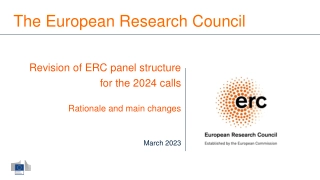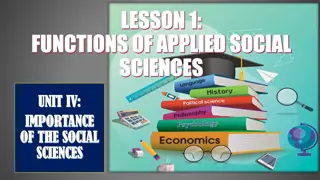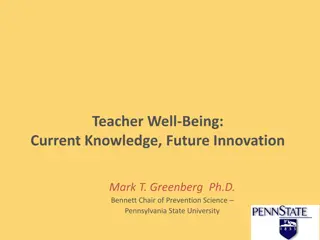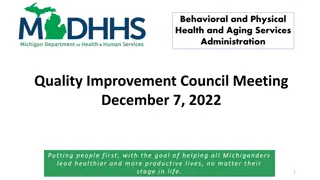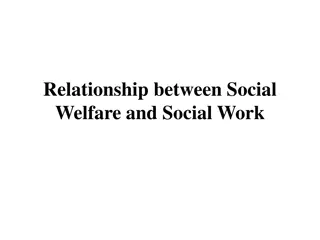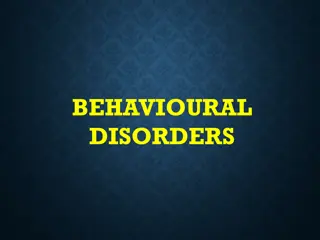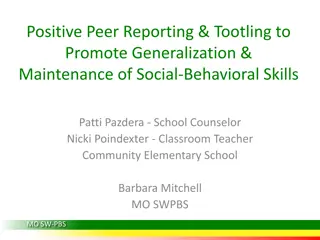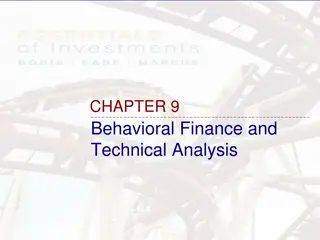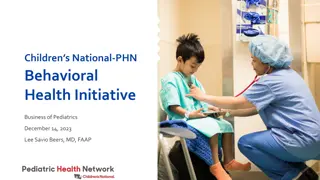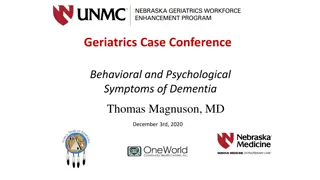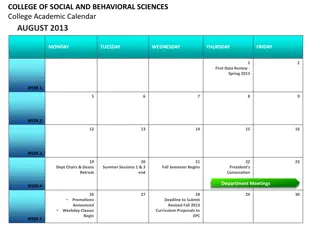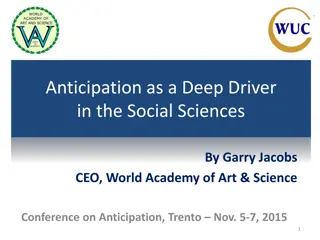Understanding University Student and Teacher Well-Being in Behavioral and Social Sciences
This research delves into the well-being challenges faced by university students and teachers in the faculty of behavioral and social sciences. It highlights the elevated levels of distress, mental health problems, and burnout experienced by students, along with the compromised well-being issues encountered by teachers. The study emphasizes the importance of exploring interactions between student and teacher well-being for a holistic approach towards improving academic performance and work satisfaction.
Download Presentation

Please find below an Image/Link to download the presentation.
The content on the website is provided AS IS for your information and personal use only. It may not be sold, licensed, or shared on other websites without obtaining consent from the author. Download presentation by click this link. If you encounter any issues during the download, it is possible that the publisher has removed the file from their server.
E N D
Presentation Transcript
faculty of behavioural and social sciences and social sciences faculty of behavioural higher education/ hoger onderwijs hoger onderwijs higher education/ 09-06-2020 09-06-2020 | | 1 1 University of Groningen Lisa Kiltz, Marjon Fokkens-Bruinsma, Ellen P.W.A. Jansen Raven Rinas, Martin Daumiller University of Augsburg If They Struggle I Cannot Sleep Well Either : Perceptions and Interactions Surrounding University Student and Teacher Well-Being
faculty of behavioural and social sciences higher education/ hoger onderwijs 09-06-2020 | 2 Research Problem University students well-being face elevated levels of distress, mental health problems, and burnout Benbassat (2014); Bewick et al. (2010); Cooke et al. (2006); Dyrbye & Shanafelt (2016), Larcombe et al. (2016); Stallman (2010); Wierenga, Landstedt, & Wyn (2013) engagement as well as positive sense of well-being increases academic performance Panger, Tryon, & Smith (2014); Stanton et al. (2016); Schaufeli et al. (2002) 1 University teachers well-being At-risk for compromised well-being: mental health problems(burnout, stress), role-conflict, ambiguity, low work-life balance Flaxman, Menard, Bond, & Kinman (2012); Hogan, Hogan, & Hodgins (2016); Padilla & Thompson (2016); Watts & Robertson (2011); Winefield et al., (2008) 2
faculty of behavioural and social sciences higher education/ hoger onderwijs 09-06-2020 | 3 Research Problem University teachers and students well-being researched in isolation from one another Evidence of well-being interaction Hagenauer & Volet (2014a, 2014b); Lundberg & Schreiner (2004); Kordts-Freudinger (2017); Postareff & Sari Lindblom-Yl nne (2011); Strauss & Volkwein (2004); Trigwell (2012); Zepke & Leach (2010) 3
faculty of behavioural and social sciences higher education/ hoger onderwijs 09-06-2020 | 4 Theoretical Background Positive Psychology Focus is not restricted to absence of ill-being, but also on presence of well-being Seligman and Csikszentmihalyi (2000, p.5), WHO (2020) Resilience An individual s ability to face negative experiences, activate resources, and bounce back to the original psychological state prior to the stressor having emerged > positive adaption, psychological growth Masten (2001); Tugade & Fredrickson (2004) Multi-faceted Approach Well-being depicts a multi-faceted term including aspects such as physical social, psychological, and emotional well-being as well as life satisfaction and engagement at work Centers for Disease Control and prevention, CDC (2018); Seligman, Forgeard, Jayawickreme, & Kern (2011); WHO (2020)
faculty of behavioural and social sciences higher education/ hoger onderwijs 09-06-2020 | 5 Theoretical Background Self-Determination Theory Deci & Ryan (2000); Kasser & Ryan (2001); Reis, Gable, & Ryan (2000); Ryan & Deci (2011); Sheldon, Ryan, & Reis (1996) Autonomy Competence Well-Being Relatedness
faculty of behavioural and social sciences higher education/ hoger onderwijs 09-06-2020 | 6 Research Goals Research Questions: RQ.1 a How do students and teachers perceive and conceptualize well- being at the university? b How do students and teachers differ in these perceptions and conceptualizations? RQ.2 a What are the direct associations between student and teacher well-being? b How do factors contributing to student and teacher well-being relate?
faculty of behavioural and social sciences higher education/ hoger onderwijs 09-06-2020 | 7 Method University of Augsburg Semi-structured Interviews (n = 16) University of Groningen Defining Well-being Can university means to you? If I asked your professor/ your students what contributes to your well-being, what do you think they would say? you tell me what well-being at the Investigating Interaction How do you think other people influence your well-being positively? Do you think student and teacher well-being are intertwined?
faculty of behavioural and social sciences higher education/ hoger onderwijs 09-06-2020 | 8 Method Initial Coding Coding Throughout RQ 1 Final Codebook Finding Overarching Themes RQ 2
faculty of behavioural and social sciences higher education/ hoger onderwijs 09-06-2020 | 9 I used to think that I had a lot of impact on students and student well-being and I could really stress myself about students who were stressful. Like yeah REALLY. So, I was the oe, laying, late at night, thinking about how should we do this, and how an we make it to the deadline. And, and um (p), so tried very, varous trhings, and I now end up thinking my, I think my role is rather limited. More limited than I originally thought. (University teacher)
faculty of behavioural and social sciences higher education/ hoger onderwijs 09-06-2020 | 10 Results
faculty of behavioural and social sciences higher education/ hoger onderwijs 09-06-2020 | 11 Questions How to tackle writing the discussion section? Which topics to include? How to combine/ report?
faculty of behavioural and social sciences higher education/ hoger onderwijs 09-06-2020 | 12 Thanks for your attention!
faculty of behavioural and social sciences higher education/ hoger onderwijs 09-06-2020 | 13 Sources Benbassat, J. (2014). Changes in wellbeing and professional values among medical undergraduate students: a narrative review of the literature. Advances in Health Sciences Education, 19(4), 597 610. Bewick, B., Koutsopouloub, G., Miles, J., Slaad, E., & Barkham, M. (2010). Changes in undergraduate students psychological well-being as they progress through university. Studies in Higher Education, 35(6), 633 645. Centers for disease control and prevention. (2018). Well-Being Concepts. https://doi.org/10.1097/01.phm.0000189841.18419.16 Cooke, R., Bewick, B. M., Barkham, M., Bradley, M., & Audin, K. (2006). Measuring, monitoring and managing the psychological well-being of first year university students. British Journal of Guidance and Counselling, 34(4), 505 517. Deci, E. L., & Ryan, R. M. (2000). The What and "Why" of Goal Pursuits: Human Needs and the Self-Determination of Behavior. Psychological Inquiry, 11(4), 227 268. Dyrbye, L., & Shanafelt, T. (2016). A narrative review on burnout experienced by medical students and residents. Medical Education, 50(1), 132 149. Flaxman, P. E., M nard, J., Bond, F. W., & Kinman, G. (2012). Academics' experiences of a respite from work: Effects of self-critical perfectionism and perseverative cognition on postrespite well-being. Journal of Applied Psychology, 97(4), 854. Hagenauer, G., & Volet, S. (2014a). I don t think I could, you know, just teach without any emotion : Exploring the nature and origin of university teachers emotions. Research Papers in Education, 29(2), 240-262. Hagenauer, G., & Volet, S. E. (2014b). Teacher student relationship at university: an important yet under-researched field. Oxford Review of Education, 40(3), 370-388. Hogan, V., Hogan, M., & Hodgins, M. (2016). A study of workaholism in Irish academics. Occupational Medicine, 66(6), 460-465. Kasser, T., & Ryan, R. M. (2001). Be careful what you wish for: Optimal functioning and the relative attainment of intrinsic and extrinsic goals. In Life goals and well-being: Towards a positive psychology of human striving (pp. 116 131). Kordts-Freudinger, R. (2017). Feel, think, teach Emotional Underpinnings of Approaches to Teaching in Higher Education. International Journal of Higher Education, 6, 217 229. doi:10.5430/ijhe.v6n1p217 Larcombe, W., Finch, S., Sore, R., Murray, C. M., Kentish, S., Mulder, R. A., Williams, D. A. (2016). Prevalence and socio-demographic correlates of psychological distress among students at an Australian university. Studies in Higher Education, 41(6), 1074 1091. Lundberg, C. A., & Schreiner, L. A. (2004). Quality and frequency of faculty-student interaction as predictors of learning: An analysis by student race/ethnicity. Journal of College Student Development, 45(5), 549-565. Masten, A. S. (2001). Ordinary magic: Resilience processes in development. American Psychologist, 56(3), 227 238. https://doi.org/10.1037/0003-066X.56.3.227 Padilla, M. A., & Thompson, J. N. (2016). Burning out faculty at doctoral research universities. Stress and Health, 32(5), 551-558. Panger, G., Tryon, J., & Smith, A. (2014). Graduate Student Happiness & Well-Being Report. https://doi.org/10.1016/j.jadohealth.2009.08.008 Postareff, L., & Lindblom-Yl nne, S. (2011). Emotions and confidence within teaching in higher education. Studies in Higher Education, 36(7), 799-813. Reis, H. T., Gable, S. L., & Ryan, R. M. (2000). Daily Well-Being: The Role of Autonomy, Competence, and Relatedness. Personality and Social Psychology Bulletin, 26, 419 435. Ryan, R. M., & Deci, E. L. (2011). A Self-Determination Theory Perspective on Social, Institutional, Cultural, and Economical Supports for Autonomy and Their Importance for Well-Being. In V. I. Chirkov, R. M. Ryan, & K. M. Sheldon (Eds.), Human Autonomy in Cross-Cultural Context. Perspectives on the Psychology of Agency, Freedom, and Well-Being (pp. 45 64). Springer Science+Business Media. Schaufeli, W. B., Mart nez, I. M., Pinto, A. M., Salanova, M., & Bakker, A. B. (2002). Burnout and Engagement in University Students. Journal of Cross-Cultural Psychology, 33(5), 464 481. Seligman, M. E. P., & Csikszentmihalyi, M. (2000). Positive Psychology. American Psychologist, 55(1), 5 14.
faculty of behavioural and social sciences higher education/ hoger onderwijs 09-06-2020 | 14 Sources Seligman, M. E. P., Forgeard, M. J. C., Jayawickreme, E., & Kern, M. L. (2011). Doing the right thing: Measuring well-being for public policy. International Journal of Wellbeing, 1(1). doi:10.5502/ijw.v1i1.15 Sheldon, K. M., Ryan, R. M., & Reis, H. T. (1996). What Makes for a Good Day? Competence and Autonomy in the Day and in the Person. Personality and Social Psychology Bulletin, 22(12), 1270 1279.Stallman, H. M. (2010). Psychological distress in university students: A comparison with general population data. Australian Psychologist, 45(4), 249 257. Stallman, H. M. (2010). Psychological distress in university students: A comparison with general population data. Australian Psychologist, 45(4), 249 257. doi.org/10.1080/00050067.2010.482109 Stanton, A., Zandvliet, D., Dhaliwal, R., & Black, T. (2016). Understanding Students Experiences of Well-Being in Learning Environments. Higher Education Studies, 6(3), 90 99. https://doi.org/10.5539/hes.v6n3p90 Strauss, L. C., & Volkwein, J. F. (2004). Predictors of student commitment at two-year and four-year institutions. The Journal of Higher Education, 75(2), 203-227. Trigwell, K. (2012). Relations between teachers emotions in teaching and their approaches to teaching in higher education. Instructional Science, 40(3), 607-621. Tugade, M. M., Fredrickson, B. L., & Feldman Barrett, L. (2004). Psychological Resilience and Positive Emotional Granularity: Examining the Benefits of Positive Emotions on Coping and Health. Journal of Personality, 72(6), 1161 1190. Watts, J., & Robertson, N. (2011). Burnout in university teaching staff: a systematic literature review. Educational Research, 53(1), 33-50. World Health Organization. (2020). Constitution. Retrieved May 10, 2020, from https://www.who.int/about/who-we-are/constitution Wierenga, A., Landstedt, E., & Wyn, J. (2013). Revisiting disadvantage in higher education. Melbourne. Winefield, A. H., Boyd, C., & Saebel, J. (2008). Job stress in university staff: An Australian research study. Australian Academic Press. Zepke, N., & Leach, L. (2010). Improving student engagement: Ten proposals for action. Active Learning in Higher Education, 11(3), 167-177.



